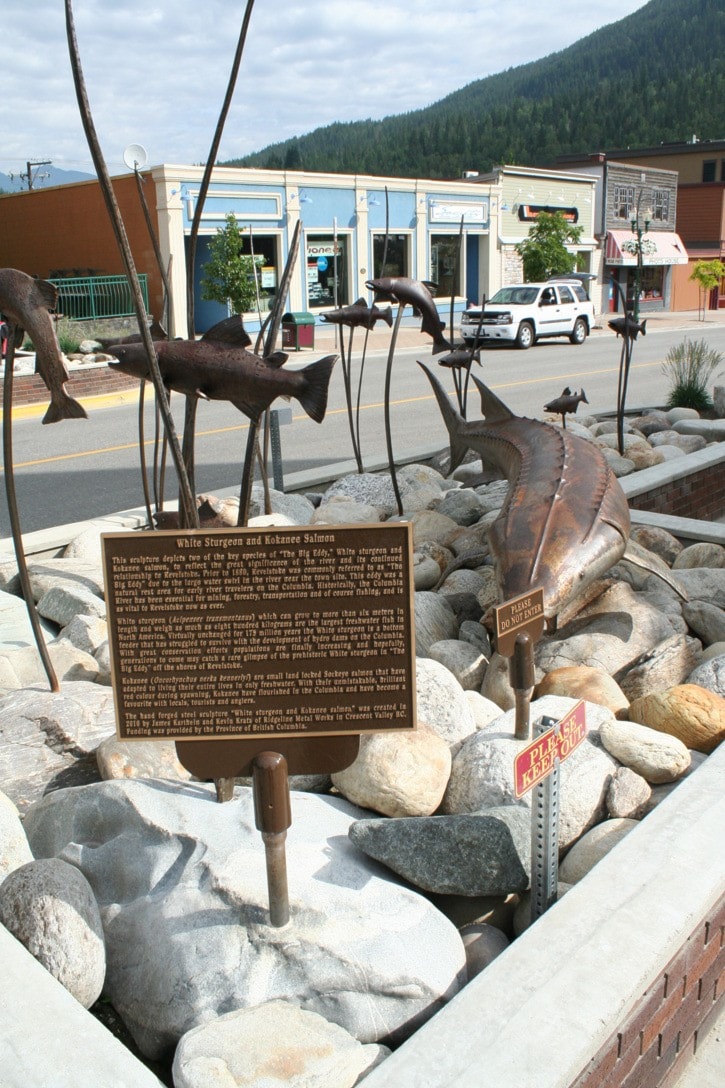Heard the one about the killer whale?
The Vancouver Canucks had to recall a batch of their trademark orca merchandise. Apparently there was a choking problem.
Heard the one about the rusty sturgeon?
Don’t joke about that – it’s just not funny. In fact, it’s emblematic of a wasteful Revelstoke city hall dumping my tax dollars down the sewer! Those Mackenzie Avenue sculptures are a literal reminder of the botched Grizzly Plaza extension because they’re rusting!
So, were Nelson-based sculptors James Karthein and Kevin Kratz back on Mackenzie Avenue on June 21 to rectify their botched job, just like the contractor who had to come back to replace the faulty, crumbling bricks on the street?
Apparently not.
Kratz explained to the Times Review that what some Revelstokians were calling rust was known to metal artists as the “patina process.” The artists were in town to apply a double-boiled mixture of turpentine, beeswax and linseed oil to the metal art that will help guide the sculptures’ aging process.
Kratz said the changes to the sturgeon that will eventually turn them to a “mottled, chocolatey red” colour were planned, and specifically outlined in the proposal they sent to the city. He explained metal artists have many options when it comes to finishes, such as powder coating or lacquering, but they chose the paste-wax method for its natural life-cycle aesthetic.
In fact, Kratz said they designed the finish of the kokanee and sturgeon differently. The kokanee were pre-rusted before installation, but the sturgeon was left a silvery colour to create a life-cycle process that mimics the wild fish’s transition from youth to maturity.
Part of the overall theme, said Kratz, was this natural process. “We’re artists, so the constant reminder of the cycle of life skews a big part of that,” Kratz explained. “You know, ‘dust to dust, ashes to ashes,’ kind of thing. We really feel there is an evolution that has to be appreciated with all these things on the earth. We’re transient, man, we’re gone in no time.”
While out on Mackenzie last week, the artists had the opportunity to interact with passers-by, get some feedback and do some explaining. Opinions varied, Kratz said: “When we were out there the other day a couple of members of the public came by and went, ‘Oh my God, this is horrendous!’ and a few others came by and went, ‘Wow, is that ever neat to see the aging process,’ so everbody’s got a different opinion.”
While in town, they also installed one of two explanatory plaques and two new ‘do not enter’ signs that will replace the ones installed by the city. The artists will have to return this week to install the other plaque after experiencing some difficulty with their equipment.
Karthein and Kratz will also return annually to apply waxings that will develop the sculptures over time. The oxidization process will be accelerated in the coming years, eventually slowing down as the sculpture settles into a final “lovely, browny-red colour.”
Re-finishing sculptures each year is commonplace. Kratz noted there is a man in B.C. who specializes as a statue polisher. He spends the entire year going from statue to statue to redo their outer coating.
So, it seems that if you don’t like the sculptures and want to carp about them, you’ll have to find another reason to skewer them besides the ‘rust.’
For the record, here is the wording on the new plaques:
White Sturgeon and Kokanee Salmon
This sculpture depicts two of the key species of “The Big Eddy,” White sturgeon and Kokanee salmon, to reflect the great significance of the river and its continued relationship to Revelstoke. Prior to 1880, Revelstoke was commonly referred to as “The Big Eddy” due to the large water swirl in the river near the town site. The eddy was a natural rest area for early river travelers on the Columbia. Historically, the Columbia River has been essential for mining, forestry, transportation and of course fishing, and is as vital to Revelstoke now as ever.
White sturgeon (Acipencer transmontanus) which can grow to more than six meters in length and weigh as much as eight hundred kilograms are the largest freshwater fish in North America. Virtually unchanged for 175 million years the White sturgeon is a bottom feeder that has struggled to survive with the development of hydro dams on the Columbia. With great conservation efforts populations are finally increasing and hopefully, generations to come may catch a rare glimpse of the prehistoric White sturgeon in “The Big Eddy” off the shores of Revelstoke.
Kokanee (Oncorhynchus nerka kennerlyi) are small land locked Sockeye salmon that have adapted to living their entire lives in only freshwater. With their unmistakable, brilliant red colour during spawning, Kokanee have flourished in the Columbia and have become a favourite with locals, tourists and anglers.
The hand forged steel sculpture “White sturgeon and Kokanee salmon” was created in 2010 by James Karthein and Kevin Kratz of Ridgeline Metal Works in Crescent Valley BC. Funding was provided by the Province of British Columbia.
